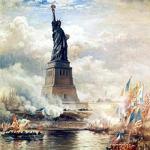SOMETHING HAPPENED: Minisinoo, Queen of X-Fic, asks: “What is ‘story’?“
Her answer: “…I view a story as a journey on which the author invites the reader. Any kind of journey, whether in space and time, or in philosophy and spirit, or in character growth. I also think ‘conflict’ of some sort is a necessary part. Some challenge has to be posed, and resolved — if only partially.
“(I don’t think it’s always necessary for a story to answer all questions, as sometimes what we share as human beings are the questions, not the answers. But I do think there’s a difference between a story that never intended to answer questions — raised them on purpose — and an author who simply wrote him/herself into a corner and now finds too many dangling plot-threads to resolve, or who’s simply lazy and uncareful. Action!Distraction and lots of blown-up buildings is not a substitute for poor plotting.)
“But … yeah, story. I think ‘journey’ and ‘challenge’ define it for me.
“But what’s ‘story’ for the rest of you?”
While I was in New Haven, I brought this up with The Rat, and she hiked out a lit-theory tome by some Russian (Shklovsky??? help me out here, people…), who basically argues that in a story–as opposed to a storyless chunk of fictional prose–we move from false assessment of the situation to true recognition. There’s still movement, but it may be movement in the reader’s mind rather than in the characters’ lives.
I initially wanted to dispute these movement-oriented definitions of “story.” I wanted to say that stories could also be chunks of fiction that change the way the reader looks at the world, without there being any movement within the story (whether false–> true or journeylike). I wanted to cite the experience Agatha Christie mentions at least once (maybe in Endless Night?) of seeing a piece of modern art and being so struck by it that afterward, the entire world looks like the art. (I presume other people have this–the thing where you find yourself thinking in the cadences of whatever you’ve been reading, and borrowing the lens of your current obsession-author.)
But I realized I was probably trying too hard to assimilate “story” into all other kinds of art. Magritte gives you a lens through which to view the world. There’s little movement in his works–even in the ones, like “Grelots roses, ciels en lambeaux,” that at first seem sequential. This moveless art, in which the artist basically jams his glasses onto your face and holds you in place until your eyes adapt, is often incredibly powerful; but that doesn’t make it “story.” And it’s worthwhile to have a category for “story” that’s separate from “imaginative prose,” so that we can discuss how different fiction writers operate. Chekhov, for one, seems to have a hard time kneading his impressions into a story. Many of his stories (“A Hard Case,” “Concerning Love”) simply stand there, like Easter Island heads, no climax or denouement and no movement from false to true. That’s one way to operate (although I think it works better for Kafkaesque parables than for Chekhovesque portraits) but yeah, it isn’t story. Make with the movement!
Also, the comments to Minisinoo’s post include a great quote from the movie “Adaptation.”











